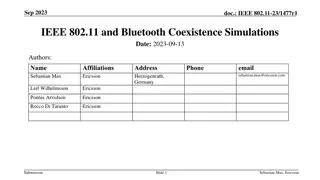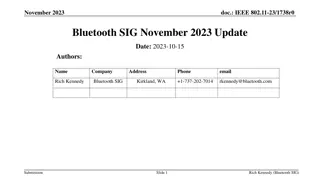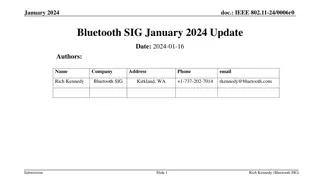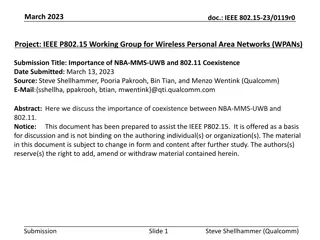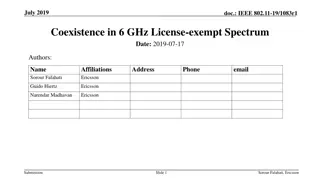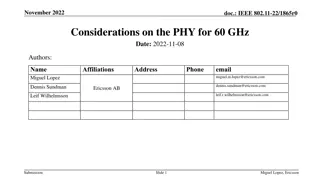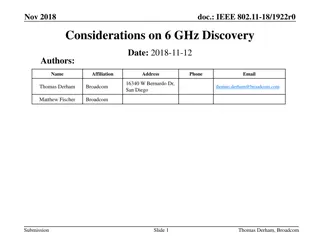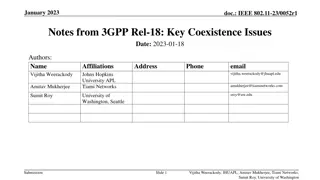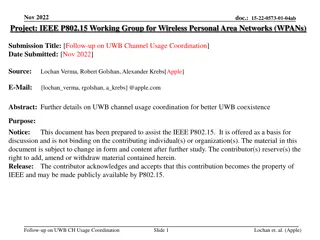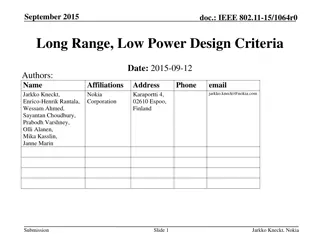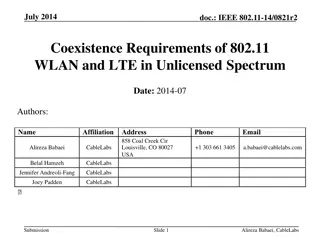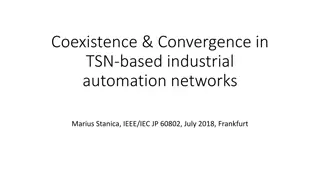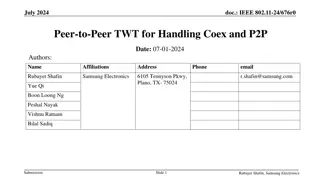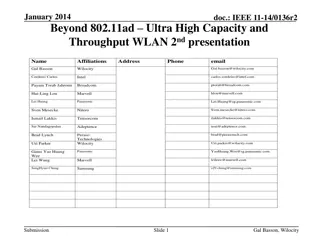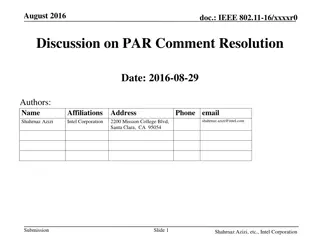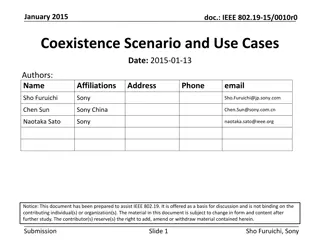Coexistence Challenges and Solutions in 6 GHz Networks
Various submissions address narrowband (NB) coexistence issues in the 6 GHz frequency band, focusing on Enhanced Detect and Avoid (eDAA) mechanisms to ensure harmonious coexistence between Wi-Fi and NB devices. The proposals discuss channel access rules, interference measurements, simulation results, and eDAA optimizations for enhanced performance. Key findings highlight the need for effective coexistence techniques to mitigate interference and enhance network reliability.
Download Presentation

Please find below an Image/Link to download the presentation.
The content on the website is provided AS IS for your information and personal use only. It may not be sold, licensed, or shared on other websites without obtaining consent from the author.If you encounter any issues during the download, it is possible that the publisher has removed the file from their server.
You are allowed to download the files provided on this website for personal or commercial use, subject to the condition that they are used lawfully. All files are the property of their respective owners.
The content on the website is provided AS IS for your information and personal use only. It may not be sold, licensed, or shared on other websites without obtaining consent from the author.
E N D
Presentation Transcript
July 2021 doc.:IEEE 802.11-21/1191r0 NB Coexistence in 6 GHz eDAA Author: Name Affiliation Address Phone Email Utrecht, mwentink qti.qualcomm.com Menzo Wentink Qualcomm The Netherlands 1 Submission Menzo Wentink, Qualcomm
July 2021 doc.:IEEE 802.11-21/1191r0 Introduction Several submissions have been made in relation to NB in 6 GHz 11-21-0832-00-coex-Narrowband-Coexistence-with-Wi-Fi-in-6-GHz BRAN(20)108038 (6 GHz VLP Narrowband) introduces NB within the existing LBT framework BRAN(21)109e003r1 (EN 303 687 NB Inputs) this document proposes to use the NB channel access rules from EN 300 328 (2.4 GHz), like DAA, MU-factor BRAN(21)109e003r1 (EN 303 687 NB Inputs) presents interference measurements between BT and Wi-Fi the results omit several key parameters, such as impact on Wi-Fi latency and full buffer throughput, and it omits several intermediate data points, suggesting a gradual reduction in throughput BRAN(21)109e008 (Wifi BT Test Setup Simulations) and BRAN(21)109h007 (NB coexistence with WB in 6 GHz) presents simulation results on coexistence between BT and Wi-Fi shows that coexistence between BT and Wi-Fi is very poor based on the EN 300 328 NB adaptivity rules, and that coexistence in 2.4 GHz is not based on the EN 300 328 mechanisms, but by Wi-Fi using FDMA and TDMA BRAN(21)109h004r2 (EN 303 687 NB Proposals for DAA Optimisation) introduces eDAA, r2 adds the exponential unavailability time BRAN(21)109j004 (NB coexistence with WB in 6 GHz eDAA) analysis of eDAA without exponential unavailability time The current submission analyzes eDAA with exponential unavailability time 2 Submission Menzo Wentink, Qualcomm
July 2021 doc.:IEEE 802.11-21/1191r0 Enhanced Detect and Avoid (eDAA) Enhanced Detect and Avoid (eDAA) has been proposed in BRAN as a method to make Wi-Fi and NB coexist the basic DAA rules are specified in EN 300 328 (2.4 GHz) the enhancements to DAA are proposed in BRAN(21)109h004r2 time between eDAA CCAs: 0.5 s channel unavailability time: 2.5 s, doubling for consecutive CCA busy events up to 40 s 20 MHz block unavailability return after 500 ms when channel is idle (not simulated yet) 3 Submission Menzo Wentink, Qualcomm
July 2021 doc.:IEEE 802.11-21/1191r0 Wi-Fi/NB test setup 11ax Wi-Fi link 80 MHz, 2ss 1201 Mbps max PHY rate (HE MCS11, 996-tone RU, NSS = 2, 800 ns GI) AP STA 10 dBm 10 dBm 60 dB A dB Variable Attenuation A dB (20 120 dB) A dB A dB A dB 60 dB NB1 10 dBm NB2 10 dBm NB link 79 MHz, 79 hops 1 MHz hop width 625 s dwell time 425 s Tx time, 200 s switch time (68% duty cycle) 3 Mbps max PHY rate (EDR 8-DPSK) (2 Mbps effective throughput at 68% duty cycle) 4 Submission Menzo Wentink, Qualcomm
July 2021 doc.:IEEE 802.11-21/1191r0 Simulation settings Wi-Fi/NB 11ax Wi-Fi link 80 MHz channel width, HE (11ax), Nss = 2 Maximum throughput about 1.1 Gbps (HE MCS11, 996-tone RU, 800 ns GI, 80 MHz, 1201 Mbps) Receive bitrate based on SINR and MCS sensitivities for MCS0 MCS11 (genie rate adaptation) NB link 79 hops, 1 MHz hop width, 79 MHz hopping bandwidth hopping sequence randomly spread equally over the 79 channels 625 s dwell time 425 s Tx time, 200 s switch time (68% duty cycle) based on Bluetooth (BT) numerology 3 Mbps PHY rate 2 Mbps effective bitrate at 68% duty cycle NB is on the same channel as the Wi-Fi link (co-channel interference) eDAA with exponential unavailability time up to 40 s, 0.5 s before CCA 5 Submission Menzo Wentink, Qualcomm
July 2021 doc.:IEEE 802.11-21/1191r0 Throughput (NB uses eDAA) (Wi-Fi/NB, interference level sweep, HE 2ss) Throughput (Mbps) 1400 1200 1000 Throughput (Mbps) the average Wi-Fi throughput is fine when eDAA is active 800 - interference level sweep 600 - NB uses eDAA 400 200 Blue: Wi-Fi throughput Red: NB throughput 0 -40 -30 -20 -10 0 10 20 30 40 SINR (dB) 6 Submission Menzo Wentink, Qualcomm
July 2021 doc.:IEEE 802.11-21/1191r0 Throughput (NB uses LBT) (Wi-Fi/NB, interference level sweep, HE 2ss) Throughput (Mbps) 1400 1200 1000 Throughput (Mbps) the average Wi-Fi throughput is also fine when LBT is active 800 - interference level sweep 600 - NB uses LBT (FBE) 400 200 Blue: Wi-Fi throughput Red: NB throughput 0 -40 -30 -20 -10 0 10 20 30 40 SINR (dB) 7 Submission Menzo Wentink, Qualcomm
July 2021 doc.:IEEE 802.11-21/1191r0 Access delay (NB uses eDAA) (Wi-Fi/NB, interference level sweep, HE 2ss) Access Delay (ms) 1000 900 800 700 but eDAA causes very high latency at both NB and Wi-Fi Access Delay (ms) 600 500 - interference level sweep - NB uses eDAA 400 300 200 100 Blue: Wi-Fi latency Red: NB latency 0 -40 -30 -20 -10 0 10 20 30 40 SINR (dB) 8 Submission Menzo Wentink, Qualcomm
July 2021 doc.:IEEE 802.11-21/1191r0 Access delay (NB uses LBT) (Wi-Fi/NB, interference level sweep, HE 2ss) Access Delay (ms) 1000 900 800 700 Access Delay (ms) 600 500 - interference level sweep - NB uses LBT (FBE) 400 300 while LBT causes low latency 200 100 Blue: Wi-Fi latency Red: NB latency 0 -40 -30 -20 -10 0 10 20 30 40 SINR (dB) 9 Submission Menzo Wentink, Qualcomm
July 2021 doc.:IEEE 802.11-21/1191r0 NB/NB test setup NB link (details below) NB1 10 dBm NB2 10 dBm 60 dB A dB Variable Attenuation A dB (20 120 dB) A dB A dB A dB 60 dB NB3 10 dBm NB4 10 dBm NB link 79 MHz, 79 hops 1 MHz hop width 625 s dwell time 425 s Tx time, 200 s switch time (68% duty cycle) 3 Mbps max PHY rate (EDR 8-DPSK) (2 Mbps effective throughput at 68% duty cycle) 10 Submission Menzo Wentink, Qualcomm
July 2021 doc.:IEEE 802.11-21/1191r0 Simulation settings NB/NB, 79 hops NB links 79 hops, 1 MHz hop width, 79 MHz hopping bandwidth hopping sequence randomly spread over the 79 channels 625 s dwell time 425 s Tx time, 200 s switch time (68% duty cycle) based on Bluetooth (BT) numerology 3 Mbps PHY rate 2 Mbps effective bitrate at 68% duty cycle NB is on the same channel as the Wi-Fi link (co-channel interference) eDAA with exponential unavailability time up to 40 s, 0.5 s before CCA 11 Submission Menzo Wentink, Qualcomm
July 2021 doc.:IEEE 802.11-21/1191r0 eDAA throughput as a function of time (NB/NB, 79 hops, high interference level, transient behavior) Rx Bitrate (Mbps) 5 4.5 the NB throughput fluctuates heavily as well 4 3.5 Rx Bitrate (Mbps) 3 2.5 - simulation at high interference level with eDAA, the NB throughput fluctates heavily 2 - eDAA with exponential unavailability time 1.5 1 0.5 0 0 10 20 30 40 50 60 70 80 90 100 Time (s) 12 Submission Menzo Wentink, Qualcomm
July 2021 doc.:IEEE 802.11-21/1191r0 LBT throughput as a function of time (NB/NB, 79 hops, high interference level, transient behavior) Rx Bitrate (Mbps) 5 4.5 4 3.5 Rx Bitrate (Mbps) 3 2.5 - simulation at high interference level with LBT, the NB throughput is essentially flat 2 - LBT (FBE) 1.5 1 0.5 0 0 50 100 150 Time (s) 13 Submission Menzo Wentink, Qualcomm
July 2021 doc.:IEEE 802.11-21/1191r0 Conclusions NB with eDAA may cause latency issues at Wi-Fi the interruptions for Wi-Fi can be 0.5 s, occurring periodically a starting Wi-Fi stream will experience 0.5 s delay before any meaningful throughput will occur eDAA also appears inadequate for NB/NB sharing the throughput is unstable and there can be very high latency spikes, due to the very high penalty on hop collisions NB links may be unable to share the same spectrum when eDAA is used LBT shows no issues for either Wi-Fi/NB or NB/NB coexistence The eDAA coexistence issues pointed out in this analysis should make it unlikely that a notified body can certify 'no-LBT' NB equipment eDAA does not appear to satisfy the requirement of an 'adequate spectrum sharing mechanism' as required by the ECC 14 Submission Menzo Wentink, Qualcomm


